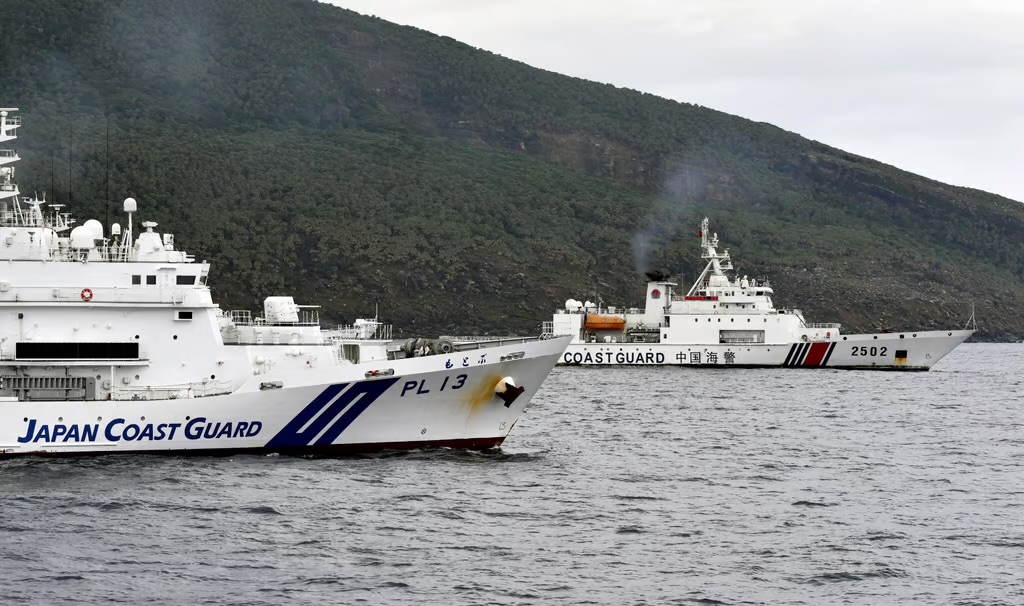Recent movements by Chinese naval vessels have sparked fears in Japan of a potential naval blockade near Okinawa in the East China Sea. This highlights Beijing’s increasing assertiveness in the region. Japanese analysts suggest that these exercises might be part of China’s broader strategy to isolate Taiwan. Along with this challenge Japan’s territorial security.
Chinese Ships Manoeuver Near Okinawa
On December 22, six Chinese vessels, including navy ships and armed coastguard vessels, conducted operations in the Miyako Strait. This 250-kilometer-wide passage separates Okinawa’s main island from Taiwan. The fleet manoeuvred through the strait into the East China Sea. By demonstrating joint naval and coastguard capabilities.
This is the first time such a coordinated exercise has been observed in the region. The operation, analysts believe, aimed to simulate a maritime blockade, a move that could hinder military and humanitarian support for Taiwan in case of a conflict.
Strategic Significance of the Miyako Strait
The Miyako Strait is a critical chokepoint in the East China Sea, linking the Pacific Ocean with mainland Asia. By potentially blockading this area, China could disrupt the movement of Japan’s Self-Defense Forces and its allies, limiting their ability to respond to regional crises.
In addition to its proximity to Taiwan, the strait is near the Senkaku Islands (referred to as the Diaoyu Islands by China), a territory administered by Japan but claimed by Beijing. Chinese coastguard vessels frequently patrol the waters around these islands, escalating tensions with Tokyo.
Implications for Taiwan and Regional Security
China’s exercises coincide with its broader objective of exerting control over Taiwan. Beijing views Taiwan as part of its territory and has vowed to reunify it with the mainland, using force if necessary. A blockade in the Miyako Strait could isolate Taiwan and deter international intervention during a conflict.
There are also concerns about the potential use of Okinawa’s outlying islands as leverage. Analysts suggest that China could isolate or even occupy these islands to pressure Japan into inaction. However, such a move would likely invoke the Japan-US Security Treaty, escalating the conflict.
Japan’s Defensive Measures
Japan has been fortifying its southwestern islands to counter the perceived threat from China. On Miyakojima, Japan has constructed a Self-Defense Forces base equipped with missile batteries. These defenses aim to deter incursions and protect critical waterways.
Tokyo has also protested against Chinese actions, including the discovery of a buoy bearing Chinese writing inside Japan’s exclusive economic zone. The buoy, equipped with meteorological equipment, is seen as another example of Beijing’s “salami-slicing” tactics, gradually asserting control over contested territories.
US and Japan’s Strategic Response
The United States and Japan have worked to contain China’s naval ambitions within the “first island chain,” a strategic boundary that includes Taiwan, Okinawa, and the Philippines. By limiting China’s access to the Pacific, they aim to prevent its navy from becoming a global “blue water” force.
China’s recent actions challenge this strategy. Joint naval patrols with Russia, frequent intrusions near Japanese waters, and ocean floor mapping operations signal Beijing’s determination to expand its influence.
Escalating Tensions Under Xi Jinping
Under President Xi Jinping, China has accelerated its military activities in the region. With enhanced naval capabilities and political resolve, Beijing is pressing ahead with its long-term strategy to dominate the East and South China Seas.
Japan remains vigilant, recognizing the potential for these maneuvers to escalate into direct confrontations. Tokyo continues to strengthen its alliances, enhance its military readiness, and assert its territorial rights in the face of growing pressure from Beijing.
Way Forward
China’s recent naval exercises near Okinawa are a stark reminder of the evolving security landscape in East Asia. By leveraging military and coastguard operations, Beijing is testing the resolve of its neighbors and asserting its territorial ambitions. For Japan, the challenge lies in responding firmly while avoiding actions that could further escalate tensions.
As regional dynamics shift, cooperation between Japan, the US, and other allies will be crucial in maintaining stability and ensuring that international waters remain free and secure.

